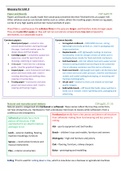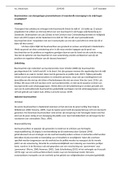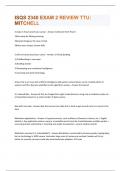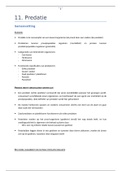Paper and Boards CGP pg20,55
Papers and boards are usually made from wood pulp converted into their finished forms at a paper mill.
Other cellulose sources can include textiles such as cotton, where the resulting paper, known as rag paper,
can be of very high quality and can last many hundreds of years.
Wood fibre is used because the cellulose fibres in the pulp are longer, and therefore make stronger paper.
They are in plentiful supply so they will not run out and are comparatively low cost compared to
alternatives; is a sustainable source.
Common papers: Common boards:
• Bleed proof paper – coated to stop • Corrugated cardboard – 1000-5000 microns, strong,
solvent based markers staining through lightweight and easily printed on. Used in packaging and
the page. Used with marker pens for impact protection.
design ideas and final designs • Duplex boards – stiff, lightweight coatings to improve
• Cartridge paper – completely opaque but functionality. Used for cheaper version of white card in
expensive. Used for pencil and ink packaging boxes mostly for food and drinks containers.
drawings, sketching or watercolours. • Foil lined board – still, foil reflects heat and a water and oil
• Grid paper – faint lines for a drawing resistant coating enables food and liquid to be contained.
guide. Used for graphical diagrams. Use in takeaway containers and lids and as a thermos.
• Layout paper – semi translucent and takes • Foam core board – lightweight and rigid in all directions but
pencil and most media well. Used in can crease and crack under pressure. Used for architectural
creating sketching and working ideas; models and model making/prototyping, or mounting and
copying or tracing ideas. framing of photographs.
• Tracing paper – translucent and takes • Ink jet card – medium to thick card treated to hold high
pencil and most colours well. Used in quality imagery.
copying and tracing images. • Solid white board – stiff board that holds colour well but is
easily cut or creased. Used in greeting cards, packaging and
advertising.
Natural and manufactured timbers CGP pg20, 27, 55
Natural wood is categorised into hardwood or softwood. These names reflect the tree they come from,
not how strong they are. Hardwood is from a deciduous tree (loses its leaves) while softwood is from a
coniferous tree (evergreen).
Hardwood generally have a less porous and denser cell structure
Softwood generally has a more than softwoods making them hard wearing and less prone to
porous cell structure, if left rotting
unprotected it can absorb moisture
and begin to rot Ash - sports equipment and tool handles
Larch – exterior cladding, flooring, Beech – children’s toys and models, furniture and veneers
machine mouldings, furniture
Mahogany – high end furniture and joinery
Spruce – construction furniture and
musical instruments Oak – flooring, furniture, railway sleepers
Pine – interior construction Balsa – prototyping and modelling
Felling à term used for cutting down a tree, which is now done via a chainsaw or agricultural machines
, Manufactured boards
Manufactured boards are usually sheets of processed natural timber waste products or veneers combined
with adhesives. They are made from waste food, low-grade timber and recycled timber.
They have a pale brown natural finish but can be covered with thin slices of high-quality wood to give the
appearance of solid wood. This covering is called a veneer which are produced by taking thin slices of a
natural wood from the trunk of a tree. They are then bonded to the surface of a cheaper sheet materials,
such as medium density fibreboard (MDF) or plywood.
Medium density fibreboard (MDF) Rigid and stable; good value with a It can be used in flat pack furniture,
smooth, easy to finish surface but toys kitchen units and internal
very absorbent so not good in high construction
humidity or damp areas
Plywood Very stable in all directions due to Can be used in furniture shelving,
alternate layering at 90°, with toys and construction
outside layers running in the same
direction
Chipboards Good compressive strength but not Can be used in flooring, low-end
water resistant and prone to furniture, kitchen units or worktops
chipping
Metals and Alloys CGP pg22, 56
Metals generally have a high strength to weight ratio and have become an essential construction material in
our modern society. Metals are categorised as either ferrous or non-ferrous, although a third group known
as alloys, is created when two or more elements are blended together, where at least one is a pure metal.
Ferrous metals are magnetic and will rust if exposed to moisture without a protective finish. Common
examples include:
Low carbon steel à used in construction gliders, screws and nails, many car bodies and bike frames
High carbon steel à used in garden or workshop tools, blades, scissors, wood and metal cutting tools
Cast iron à used in kitchen pots and pans, machine bases and bodies, vices and manhole covers
Non-ferrous metals are a group of metals that are generally not magnetic and does not contain iron. They
do not rust, but can oxidise. Oxidation causes the surface of the metal to change colour and dull with time.
Common examples include:
Aluminium à used in pots and pans, sports car body panels, bike frames, drink cans, foil or take away trays
Copper à used in plumbing supplies, electrical cables, bespoke roofing and guttering
Tin à used in can production, in plating services
Zinc à used in galvanization (the process of applying a protective zinc coating to steel or iron, to prevent
rusting), or used in alloys.








